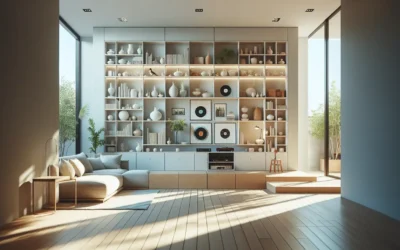“A home is not simply a structure. It’s a living organism—capable of holding memory, rhythm, and generations of care.”
There’s a quiet renaissance happening behind suburban fences and urban brownstones alike. It’s not driven by trend or necessity alone, but by something older and deeper: a return to the long-view of family. The multigenerational home—once common, then rare—is making a graceful comeback.
Three generations under one roof doesn’t mean compromise. It means opportunity. For financial resilience. For cross-generational growth. For building a life where wisdom, wonder, and caretaking are no longer isolated but interwoven. But for this to thrive, design must rise to meet the complexity of modern family life—with grace, foresight, and flexibility.
Rethinking the Family Structure
The nuclear family ideal dominated much of 20th-century design. Yet as families realize the cost of housing increases for the younger generations, read the longevity studies, have a need for shared caregiving responsibilities or just a realization that they have greater potential to thrive together- the idea of multigenerational living has gained popularity. According to Pew Research, 1 in 5 Americans now live in multigenerational households—a figure that has quadrupled since 1971.
Behind this shift are the rising housing costs, longer lifespans, and shifting cultural values. But at the heart of it is a deeper wisdom of living helping each other. Grandparents who once lived hours away are now down the hall. Children can grow up with more help around the house and adults guiding them. Aging is no longer synonymous with isolation.
When designed with intention, these homes don’t just work logistically—they can become emotionally sustainable ecosystems.
The Emotional and Financial Upside
Built-In Support System
Children benefit from the presence of grandparents not just emotionally, but developmentally. Studies show increased empathy, academic performance, and resilience in children who grow up with daily intergenerational contact.
Likewise, elders living with family report longer life spans and improved mental health.
Financial Resilience
Shared living distributes costs: mortgages, utilities, and childcare become collective efforts. In many households, this allows younger adults to save for their own homes while older adults maintain independence longer.
Cultural Continuity
Multigenerational homes are fertile ground for passing down traditions—whether through language, recipes, or family rituals. This cultural continuity can be designed into the home through shared cooking spaces, storytelling nooks, or even altars that reflect heritage.
Design Principles for Multigenerational Living
Privacy Is Not a Luxury—It’s a Non-Negotiable
Start by zoning the home like a boutique hotel. Each generation should have a “suite” or wing—a space to retreat and recharge. Sound insulation, separate entrances, or even ADU (Accessory Dwelling Unit) conversions can turn crowding into comfort.
Create Shared Ritual Spaces
Design spaces that invite connection: a generous dining table, a cozy hearth, a sunlit porch. These areas become neutral ground, places for spontaneous connection that reinforce family rhythm.
Universal Design for All Ages, Accessibility and Aging in Place
Design with tomorrow in mind. Single-level living, no-step entries, grab-bar reinforcement behind tile, and wider doorways ensure that no one will have to move out to age with dignity. Ideally place plates/bowls glasses within range of children and wheelchairs.
Flexible Furniture and Functions if a Small Space and Reinforced Sound Barriers
Built-ins with dual uses, Murphy beds, and sliding doors create adaptable spaces if dealing with a small space. A playroom can become a study, a guest room an elder’s suite. Use the wall insulation, hallway rugs and seals around the doors to prevent sound transmition.
Common Challenges—and How to Design Around Them
1. Lack of Privacy
Solution: Separate bathrooms. Pocket doors. Zoned HVAC systems. Even thoughtful lighting cues—dimmer switches or directional sconces—can subtly mark territory.
2. Lifestyle Conflicts
Solution: Establish ‘quiet hours,’ shared calendars, and a set of ‘house rhythms.’ If possible, provide each generation with a kitchenette or coffee bar—so early risers and night owls can peacefully coexist.
3. Decision-Making Fatigue
Solution: Before move-in, co-create a family values document—covering everything from household chores to boundaries. Design choices should flow from these agreements, not vice versa.
Real Homes, Real Stories
The Greenfield Farmhouse | Columbia, Missouri
When the Greenfields converted their aging barn into a light-filled living space, it allowed Grandma June to live independently—yet within arm’s reach of her grandkids. With its own entry and kitchenette, the space strikes a balance between togetherness and autonomy.
The Yamada Compound | Los Angeles, CA
Three generations, two languages, and one smart layout. The Yamadas opted for a courtyard-style floor plan. Each family unit faces a central garden, where they gather nightly. “It feels like we live in different houses that happen to share a soul,” says Aiko, the family’s matriarch.
The Rivera Bungalow | Sarasota, FL
A Spanish-style home reimagined with universal design principles. Wide hallways, low thresholds, and warm natural materials make aging invisible—but beautifully accommodated. The family eats together in a breezy open-concept kitchen, while the guest casita functions as both an art studio and future caregiver suite.
The Takeaway
Designing for multigenerational living isn’t about fitting more people into a space. It’s about expanding the meaning of home. When done well, the result is not a crowded house—but a layered one. One that holds memory, momentum, and mutual respect.
If we approach this with the right mindset and the right materials, we don’t just make room for our families—we make room for a richer kind of life.
Considering a multigenerational home—or renovating one to better serve your family’s needs? Explore our 2-Hour Design Consultation or browse the RachelBlindauer.com blog for more design-forward strategies on how to live well—together.




